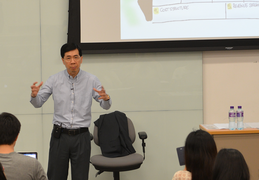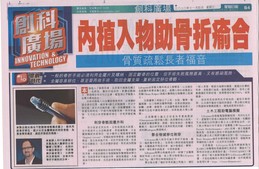HKU’s innovative research novelties excel at 48th International Exhibition of Inventions of Geneva
29 Apr 2023
Back to NewsHKU’s innovative research novelties excel at 48th International Exhibition of Inventions of Geneva

The University of Hong Kong (HKU) triumphed at the 48th International Exhibition of Inventions of Geneva, winning a total of 19 awards, including two special grand prizes Invention & Innovation CAI Award (China Delegation), and Prize of the Delegation of Malaysia. The results were announced yesterday (April 28).
Research teams from Faculty of Architecture, Faculty of Engineering, Faculty of Science, LKS Faculty of Medicine, and two HKU Inno Laboratories, established under the Hong Kong Government's InnoHK programme, garnered two special grand prizes, one Gold Medal with the Congratulations of the Jury, six Gold Medals, six Silver Medals and four Bronze Medals with their innovations in the event.
The Artificial Intelligence MGF Network for Anomalies Detection, developed by Dr Wilton Fok's team from the Department of Electrical and Electronic Engineering, was winner of the two grand prizes and a gold medal. The system uses AI to analyse in real time human posture and movements in a video to identify anomaly scenarios such as abuse, drowning, and criminal behaviour.
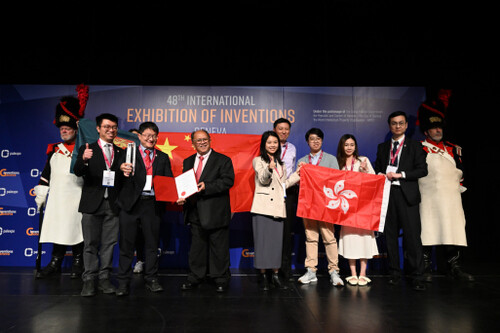
Artificial Intelligence MGF Network for Anomalies Detection, developed by Dr Wilton Fok's team, wins two special grand prizes Invention & Innovation CAI Award (China Delegation) and Prize of the Delegation of Malaysia, and a gold medal
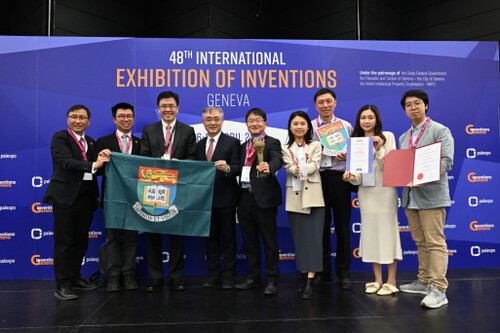 Artificial Intelligence MGF Network for Anomalies Detection, developed by Dr Wilton Fok's team, wins two special grand prizes Invention & Innovation CAI Award (China Delegation) and Prize of the Delegation of Malaysia, and a gold medal
Artificial Intelligence MGF Network for Anomalies Detection, developed by Dr Wilton Fok's team, wins two special grand prizes Invention & Innovation CAI Award (China Delegation) and Prize of the Delegation of Malaysia, and a gold medal
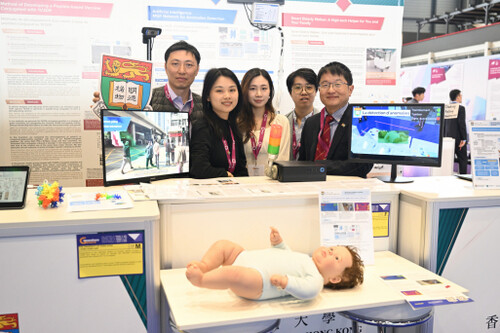
Artificial Intelligence MGF Network for Anomalies Detection developed by Dr Wilton Fok's team
The Programmable Cell Niche Engineering Platform, developed by Professor Barbara Chan's team from the Department of Mechanical Engineering, won a Gold Medal with the Congratulations of the Jury. The system ensures proper cellular functions and results that can enable predictable clinical studies by mimicing the biological environment for cells.
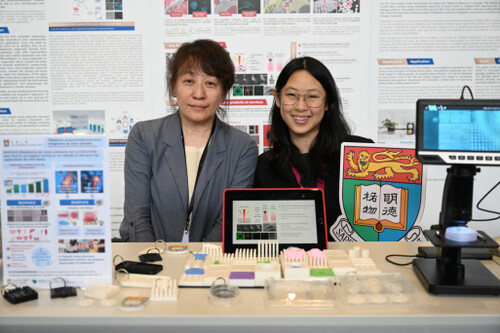 The Programmable Cell Niche Engineering Platform, developed by Professor Barbara Chan's team, wins a Gold Medal with the Congratulations of the Jury
The Programmable Cell Niche Engineering Platform, developed by Professor Barbara Chan's team, wins a Gold Medal with the Congratulations of the Jury
HKU has showcased this year a total of 17 research inventions that provide solutions to pressing human problems, spanning diverse areas such as biomedicine, vaccine development, artificial intelligence, and aging. Notably, the Advanced Biomedical Instrumentation Centre and the Centre for Virology, Vaccinology and Therapeutics, established by HKU in 2021 under the Hong Kong Government's InnoHK program, have demonstrated exceptional ability in successfully translating their biomedical research achievements into practical applications within a relatively short timeframe. Each have two research inventions selected, including an aptasensor for sepsis diagnosis, a capillary microfluidic platform for point-of-care testing, an interferon-integrated coronavirus vaccine, and NanoComplex vaccine technology.
“HKU takes immense pride in the recognition our researchers have received for their innovative research efforts. We are also dedicated to facilitating the transfer of our research findings into tangible applications in the market. Through the powerful synergies generated from our collaborations with global research and industry partners, we strive to facilitate the emergence of pioneering innovations and their transformation into products that improve the well-being of humanity,” said Professor Max Shen, Vice-President and Pro-Vice-Chancellor (Research).
Renowned as one of the most distinguished innovation exhibitions in the world, the International Exhibition of Inventions of Geneva (IEIG) is an extraordinary annual global event devoted exclusively to inventions and innovations.
Since first participating in the event in 2018, HKU has received a total of 60 awards including 4 prestigious Gold Medals with Congratulations of the Jury and 21 other gold medals.
HKU’s award-winning inventions in 2023:
INVENTION & INNOVATION CAI AWARD (China Delegation) & PRIZE OF THE DELEGATION OF MALAYSIA & GOLD MEDAL
Artificial Intelligence MGF Network for Anomalies Detection
The invention can be deployed in children's centres, swimming pools, public transport and exhibition centres to detect abnormal behaviours and situations for public safety and security. Using AI to detect human skeletons in a video and analyse their posture and movements, it is able to capture the context information in a long video and address specific portions for detecting multiple anomaly scenarios in real time such as abuse, drowning, terrorist attacks, traffic accidents, fighting and criminal behaviour, more accurately and efficiently.
The invention was developed by the research team of Dr Wilton Fok from the Department of Electrical and Electronic Engineering, The University of Hong Kong.
GOLD MEDALS WITH CONGRATULATIONS OF THE JURY
Programmable Cell Niche Engineering Platform
One of the reasons many drugs that work in the lab do not work as expected in the clinical trial stage is that scientists grow cells on flat and rigid culture dishes for drug research, which are not biomimetic -- leading to cell responses in lab testing that do not represent what would happen in native tissues of human bodies. The Programmable Cell Niche Engineering Platform mimics the biological environment for cells, which in turn ensures proper cellular functions and results that can enable predictable clinical studies. The multifactorial biochips invented identify the ideal niche for different cell types, equipping scientists with a comprehensive library of individual niche factors to develop optimal culture environments for different types of cells of specialised applications.
The platform was developed by Professor Barbara Chan and her team from the Department of Mechanical Engineering, Biomedical Engineering Programme, The University of Hong Kong.
GOLD MEDALS
1. Respiratory Organoids
Biomedical research mainly relies on cell lines and animal models for experimentation, which has limited physiological relevance to human biology and pathology. Under this project, a complete respiratory organoid culture system has been the first of its kind to efficiently reconstruct and reproducibly expand the entire human respiratory epithelium in culture plates. All the differentiated respiratory organoids, including nasal, airway and alveolar organoids, adequately mimic the multicellular composition of native respiratory epithelium and phenocopy the functionality. Superior to most existing in vitro models, these organoids represent universal tools with biological relevance for diverse biomedical and pharmaceutical applications, including disease modeling, development of therapeutics, toxicological evaluation and personalised medicine.
The project was originated by Dr Jie Zhou, Dr Man Chun Chiu, Dr Cun Li and Professor Kwok Yung Yuen from the Department of Microbiology, The University of Hong Kong.
2. Bismuth-based Cocktail Therapy for Coronavirus
There is an urgent need for safe and effective therapeutic options for COVID-19, with the SARS-CoV-2 variants associated with enhanced transmissibility, reduced vaccine-induced protection and emerging drug resistance. Under this project, the orally administrated bismuth drug colloidal bismuth subcitrate together with N-acetyl cysteine has been found to be a broad-spectrum anti-coronavirus cocktail therapy against multiple SARS-CoV-2 variants and different coronaviruses. Mixing two US Food and Drug Administration (FDA) approved over counter drugs, 1 molar equivalent of colloidal bismuth subcitrate and 3 molar equivalents of a mucoactive drug N-acetyl cysteine, is a safe and highly potent therapy through oral administration and 10 times more selective in killing the virus than the first FDA approved drug. This therapy is now in phase II/III clinical trial in Hong Kong, with a phase III trial underway in China.
The invention was developed by Professor Sun Hongzhe, Professor Yuen Kwok-yung, Dr Yuan Shuofeng, Dr Wang RunMing, Dr Li Hongyan, Dr Jasper Chan Fuk-Woo, Dr Cheng Tianfan, Mrs Wang SuYu, and Mr Chan Chun Lung of The University of Hong Kong.
3. PERfECT Wearables for Digital Health
Endorsed by over 100 leading scientists worldwide on social media, "HKU PERfECT" is the first wearable platform combining the distinctive features of being highly sensitive, energy efficient, lightweight and ultracompact, enabling decentralised medical technologies for remote and personalised healthcare to cope with an aging population, quarantine and the shortage of medical instrumentation. Compared to current wearable devices that can only measure vital signals (e.g. heart rate, breathing rate, blood pressure, etc.), PERfECT is able to detect molecular indicators in body fluids, which are more informative for fatal/chronic disease screening and monitoring.
The invention was developed by the WISE Research Group from The University of Hong Kong and SESIC LIMITED.
4. Method of Developing a Peptide-based Vaccine Conjugated with 1V209
This invention describes the development of a method to conjugate 1V209, a toll-like receptor 7 (TLR7) agonist, to antigens to induce antigen-specific responses. Past synthetic peptide vaccines must be used together with vaccine adjuvants to stimulate T cells against specific antigens to treat cancer, but a simple mixture of antigens and adjuvants can hardly induce enough specific immune responses. To address this issue, we designed bioinspired nanoparticles mimicking the structure of the virus to enhance the antigen-specific immune response. Through safer and greener methods, it used the TLR7 agonist 1V209 to generate peptide-drug conjugates and form a self-adjuvating vaccine to deliver antigens and adjuvants at the same time, inducing a stronger T cell response with improved stability and successful suppression of tumour growth.
The invention was developed by Professor Jiandong Huang and Dr Yefan Hu from the School of Biomedical Sciences, The University of Hong Kong.
5. DipμChip – Capillary Microfluidic Platform for Point-of-care Diagnostics
DipμChip is an automated capillary microfluidic-based point-of-care (POC) microsystem allowing rapid and portable detection of various high-impact and mortality diseases. It is designed and fabricated using state-of-the-art molecular biology and microfluidic technologies, utilising capillary pressure and surface-activating treatments that allow laboratory-level analytics to be conducted in an accessible manner. This microsystem paves the way for a versatile array of clinical and academic applications that require multiple conjugations and washings. End users of DipμChip include clinics, hospitals, homes and assisted living healthcare facilities, democratising access to adequate clinical care, and saving precious lives of patients in need.
The platform was developed by the Advanced Biomedical Instrumentation Centre.
SILVER MEDALS
1. Smart Address Plates for Pedestrian Indoor Navigation and Location-Based Services and Management
Traditionally, pedestrian navigation uses Location Positioning System (LPS) with trilateration to find the user’s position, which have very high positioning error for outdoor GPS and indoor positioning. This new solution adopts a cost-effective innovative Location Confirmation System (LCS) to accurately locate and guide the user to the destination by using Smart Address Plates (SAP) that transmit stored geographic coordinates with innovative 3D Smart Address (SA) codes to the users even without WiFi or telephone signals. This SAP system can help to find shops/ offices/ restaurants/ car parking spaces inside a multi-storey building accurately while providing location-based services and management for precise target marketing. It is highly scalable, connecting shops/rooms on a floor to a building, then to a district and to the whole city through a Smart Address Plate Management System (SAP-MS).
The Smart Address Plates and Location Confirmation System were developed by Professor Anthony Yeh, Dr Zhong Teng and Dr Run Shi from the Department of Urban Planning and Design, The University of Hong Kong.
2. A Novel Stem Cell-based Platform for Antiviral Discovery, Vaccine and Healthy Natural Products
There is an urgent need for the vaccine industry to establish a new type of human cell model for anti-virus drug development in order to enhance sensitivity and efficiency. The human Expanded Potential Stem Cells (hEPSCs) developed under this project help generate trophoblast stem cells (TSCs) and syncytiotrophoblasts (STBs), which express high levels of SARS-CoV-2 host factors and are highly susceptible to the viral infection. Remarkably, the infected eSTBs are 1,000 times more sensitive to antiviral drugs, making the TSC-STB platform a more ideal human cell source for viral production and performing antiviral discovery, including SARS-CoV-2, MERS, their variants, and the FDA approved anti-virus drugs and natural products.
The platform was developed by Professor Pengtao Liu from the Li Ka Shing Faculty of Medicine, and Dr Degong Ruan and Professor Fang Liu from the Centre for Translational Stem Cell Biology, The University of Hong Kong.
3. Ultra-thin Flexible Robotic Instruments for Endoluminal Surgery
Under this project, a robotic system with highly miniaturised and flexible instruments has been developed to address challenges in the endoluminal treatment of early-stage gastrointestinal and urinary tract cancers. In current practice, there is a steep learning curve for resecting tumours in their entirety due to a lack of instrument dexterity and poor tissue retraction. The developed system provides two robotic instruments as small as Ø2.5 mm with 5 degrees of freedom each, enabling enhanced endoluminal surgery with conventional rigid and flexible endoscopes. Overall, the system will help to flatten the learning curve so that more clinicians can provide patients with effective early-stage care.
The system was developed by the research team of Dr Ka-Wai Kwok from the Department of Mechanical Engineering, The University of Hong Kong.
4. Automatic Alignment of Microparticles
This groundbreaking chip-size invention revolutionises the way to align micro-particles in liquids. Using a microchannel with specifically arranged roadblocks that effortlessly guides disordered particles into an ultrafast-flowing chain, it provides outstanding performance at a low cost. As compact as a credit card and priced at less than USD10, each device can align up to one million particles per minute with precision down to 0.001 mm. This game-changer bypasses the limitations of current methods, thereby enhancing the efficiency of applications that involve microparticle analysis and processing, particularly blood cell screening and water filtration.
The invention was developed by Professor Kevin Tsia and Dr Kelvin Lee from the Department of Electrical and Electronic Engineering, The University of Hong Kong.
5. Interferon-integrated coronavirus vaccine: a next-generation universal live vaccine protects against pan beta-coronavirus infection
In the wake of the COVID-19 pandemic, it is imperative to develop a next-generation coronavirus vaccine that can offer protection against current and potential future beta-coronavirus infections. However, there are several technical hurdles that must be overcome in order to create an ideal vaccine that has three key properties: 1) universal protection against a broad range of beta-coronaviruses, 2) enhanced mucosal T cell immunity, and 3) activated innate anti-viral mechanisms to ensure safety. The team has developed an innovative immunological design and genetic engineering technology that has resulted in the creation of a universal beta-coronavirus mucosal vaccine and a streamlined production pipeline. Preclinical studies in two animal models have demonstrated the efficacy of the vaccine in terms of the three key properties.
The technology was developed by Dr KH Kok and the team from the Department of Microbiology of The University of Hong Kong and the Centre for Virology, Vaccinology and Therapeutics.
6. NanoComplex
NanoComplex is a next-generation vaccine technology designed for nasal use and carries the potential to target all kinds of viruses. Viruses have proteins as antigens and nucleic acids as genomes, and both are critical components to alert our immune system and generate strong protection. The NanoComplex technology takes full advantage of these components, combines viral proteins and nucleic acids with innovative methods, and creates a nano-sized complex that can be used as a nasal vaccine. Since all viruses have the same components, the NanoComplex can switch its internals for different viruses, and therefore can potentially defend against all known viruses.
The technology was developed by a research team lead by Dr Kin Hang Kok from the Department of Microbiology of The University of Hong Kong, and the Centre for Virology, Vaccinology and Therapeutics.
BRONZE MEDALS
1. Remote e-Inspection System for the Manufacturing and Delivery of Offsite Modular Construction
This e-Inspection System is a Modular Construction Supply Chain Quality Assurance system that includes i-Core (an loT device attached to each MC module to monitor the position, humidity, temperature and collision data), e-InStar (an App for uploading the checking result of each production step in a remote factory to the block chain), e-TranStar (an App for monitoring the location and condition of the MC module in the transport process) and a blockchain-based backend. Designed for offsite modular construction use to help solve housing problems, it reduces resources required for supervision and paperwork while ensuring tamper-proof data, helping overcome the current difficulties in monitoring the quality of production and transportation from remote sites. The system has been piloted in an HKU project in Hong Kong with two 17-storey buildings using 952 MiC modules.
The system was developed by Prof Wilson Lu, Director of the iLab of the Faculty of Architecture, together with Professor Anthony Yeh, Chair Professor of the Department of Urban Planning and Design, and Mr KL Tam, Former Director of the Estates Office of The University of Hong Kong.
2. On-site Fertilizer Production for Perpetual Farming
The EC Flow device developed under this project is an energy-neutral system that fully integrates with solar panels and battery storage systems to detect and remove numerous toxic residual nitrates and nitrites (NOx) in soil using renewable energy. It can further upcycle NOx and feed fertilizer back into urban farming sites, achieving waste remediation, pollution mitigation and resource recovery to reach nitrogen neutrality. This solution can be applied to plantation areas of any scale and type, including farms, lawns, roof gardens and balconies. The goals are lowering toxin levels in municipal waste and alleviating ecological strains on urban sewage systems, ultimately improving the urban municipal discharge situation and local marine environment.
The device was innovated by Dr Edmund Tse, Wanying Wang from the Department of Chemistry, The University of Hong Kong, and commercialised with the help of Yip Jackson Ho So.
3. Smart Elderly Walker
This is a smart and handy device pairing advanced Artificial Intelligence with a home-friendly design, helping the elderly stay healthy, active and independent while making their lives easier and more secure. It brings together several advanced features, including a stable mechanical structure with smooth omnidirectional mobility, dual-mode actuation and control for simultaneous walking/standing support and fall prevention/recovery, soft robotic handles and privacy-friendly sensors for event detection and control and fall detection, as well as specialised sound-source localisation to locate the user quickly and effectively, providing enhanced safety protection and superior walking assistance for older adults.
The device was developed by the research team of Professor Chuan Wu, Dr Hao Luo, Dr Zhao Chongyu and Dr Wen Rongwei from the Department of Computer Science of The University of Hong Kong; and Professor Wang Zheng from the Department of Mechanical and Energy Engineering of The Southern University of Science and Technology in Shenzhen.
4. Aptasensor for Sepsis Diagnostic
Diagnosing sepsis in a timely manner to ensure optimal patient survival with prompt treatment remains a major challenge. This invention utilises a novel DNA-based biosensor that integrates aptamers into a point-of-care platform to advance sepsis diagnosis. Aptamers recognise biomarkers by specifically binding to unique structures on their surface. Unlike antibody-based tools, aptamers provide multiple advantages in terms of stability, production cost, reproducibility and flexibility that can readily be integrated into various platforms, such as electrochemical platforms (quantitative device) and/or colorimetric assays (rapid test). The aptasensor provides a quick and highly sensitive solution for sepsis detection that can help revolutionise point-of-care sepsis detection.
The invention was developed by Dr. Louisa Hoi-Ying Lo, Dr. William Whitehouse, supervised by Professor Julian Tanner, from the Advanced Biomedical Instrumentation Centre.
The University’s participation in this year’s competition was coordinated by the Technology Transfer Office of HKU. For details about the International Exhibition of Inventions of Geneva, please visit: https://inventions-geneva.ch/en/home/.
Back to News
Entrepreneurs in Action – How to Put Everything Together and Get it Started, with Limited Resources
30 Apr 2014
E-Newsletter
Get the latest technology and news from us
If you do not wish to receive emails from us in the future, you can send an unsubscribe request to us by email to info@tto.hku.hk.




